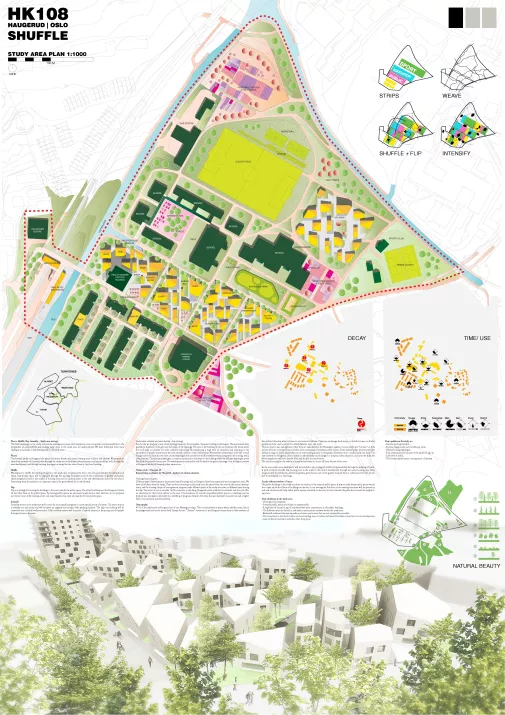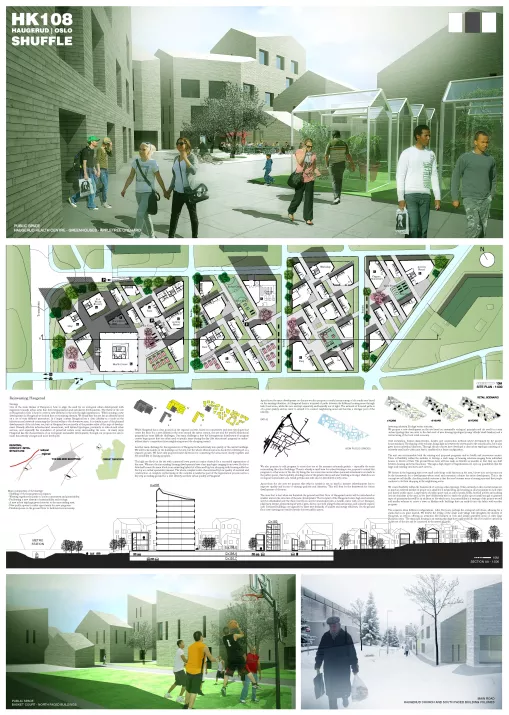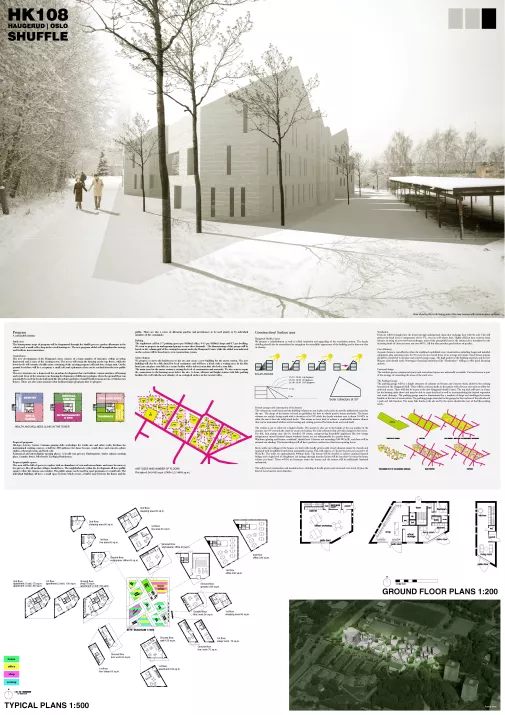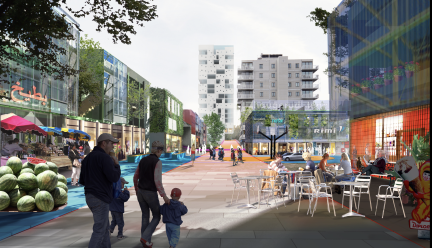Project:
Shuffle
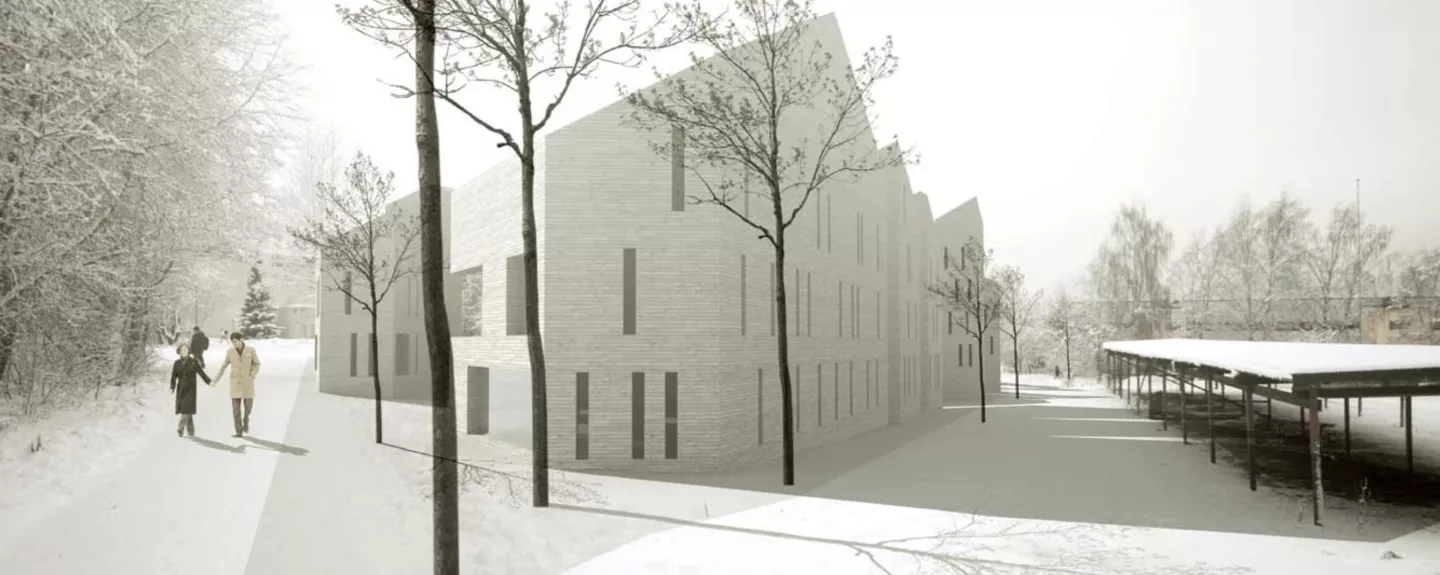
About
-
SHUFFLE
Weave, Shuffle, Flip, Intensify: Study Area StrategyThe main challenges in the study area are the homogenous zones that undermine cross connections and permeability. In the perspective of sustainability and ecology, large areas in the study area are under- utilised. We have developed three main strategies to facilitate a new development in this area:
Weave
The forested paths on Haugerud are places of natural beauty that create a strong sense of place and identity. We propose to extend this network throughout the study area to facilitate interconnections and permeability in both the new developments and existing homogenous strips, such as the school area or social housing.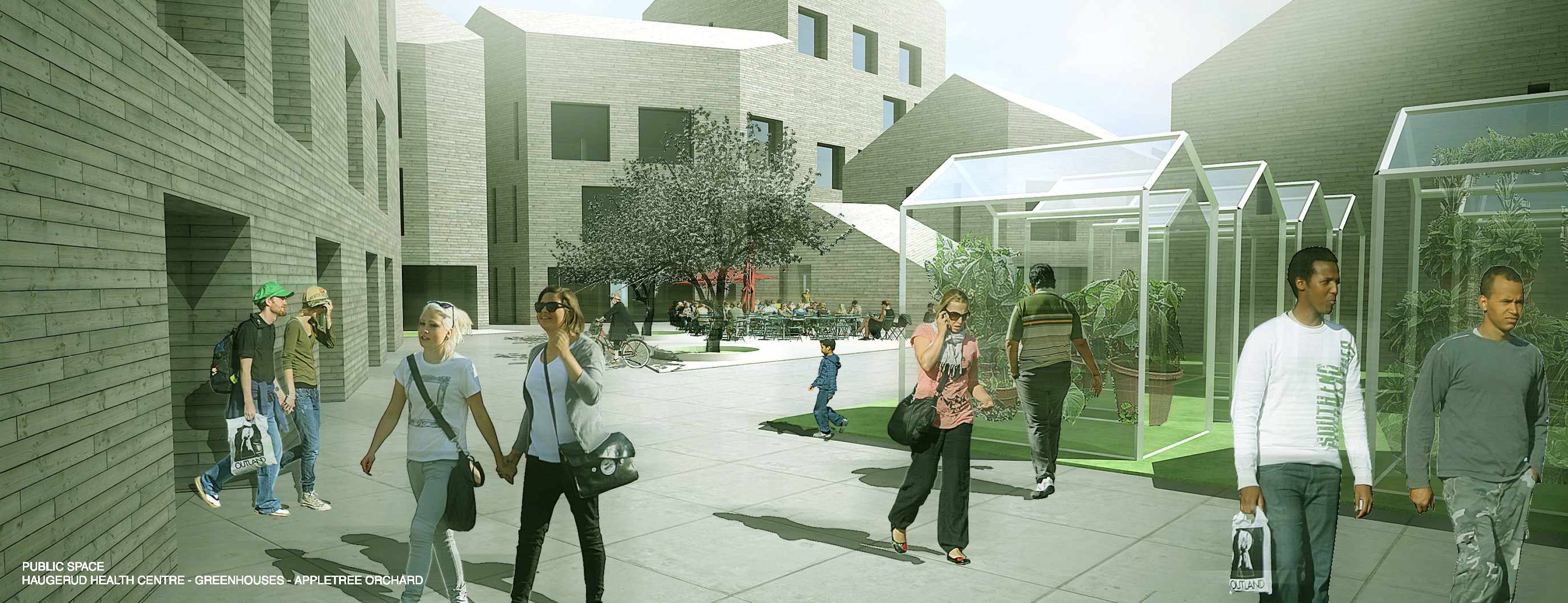
Shuffle
We propose to shuffle the existing programme in the study area to enhance the quality of life and intensify the utilization of space. Low quality space will be upgraded through this strategy. Potential examples could be sports fields in housing areas, garden allotments, or an activity center shared by the school in the new development. Penetrating the boundaries presented in these areas is an important step in laying the groundwork for a new identity.Flip
Flip is a strategy for turning the buildings in the area towards the public space. The school buildings and the centre all turn their back on the public space. When creating public spaces we want also to give them a clear direction. In our proposal we remove most of the existing centre and make façades that open up towards the new public space.Sustainable Urbanity and New Identity – Site Strategy How to align the need for ecological urban development, while migration towards urban areas is fueling overpopulation and speculative development? For the site, a new urban typology based on the principles of passive building technologies is introduced. These principles have guided the direction of the grid and the shape of the typology. The cuts in the buildings let the sun penetrate the blocks, while the roof angle is adjusted for solar collector technology. By introducing a high level of structures, and adjusting to the parameters of passive construction we have created a diverse urban environment. We want the development to be like a small village. To facilitate that process we have created typologies that can shuffle between various programmes like housing, retail, cafés, bars etc. The main principles of passive technologies give a common construction and shape to the buildings while the different typologies create flexibility for future uses. The development is sustainable and fits within the general strategy of an ecological enclave at Haugerud while still keeping urban aspirations.

Inventing Urbanity: Ecology Versus Intensity
We propose a new development based on sustainable ecological principles and the need for a semi-urban typology. It will need to cater to the different needs of new housing typologies (young, elderly, small families), and contribute to a restructuring of the local retail economy. Grid orientation, formal characteristics, façades and construction methods are determined by the passive housing standard. Through this process we have developed a clear urban typology consisting of a relatively small scale urban unit that is combined with a dense configuration. The unit can accommodate both the existing and proposed programmes, such as health and recreation centers. There is flexibility within the modules to develop a wide range of housing solutions ranging from individual houses to blocks of flats. The ground floors have all been made as flexible as possible so they can shift between housing and retail functions. Through a high degree of fragmentation we open up possibilities that the large scale existing structures can’t accommodate. We foresee the possibility of a few small scale shops functioning in the area inthe beginning, but also the potential for retail and recreation to colonise the entire development. Another possible outcome is that the area becomes more residential and people continue to do their shopping in the neighboring areas. We wish to create flexibility within the framework of a strong urban typology. This is the concept we call shuffle.
Urban intensity in this context is not so much about an extreme number of people on a small lot than it is about having people living and working in close proximity to each other and sharing public space. Larger types of public space such as school yards, fields, football pitches and parking lots are abundant in the area. Because of this we have deliberately tried to make the public spaces small enough so as to generate types of proximity that will be an addition to the whole area. As permeability is a strategy of the project, we will add smaller volumes to create a town with buildings that can easily fit into the fabric of another programme. The scenarios show different configurations. Perhaps the ecological café closes after five years, allowing for a studio flat to take its place. We believe the feeling of the small scale village that this flexibility creates will strengthen the identity of Haugerud, as well as offer an attraction. Municipal housing is an existing typology that could work if it could be opened up to the rest of the site and connected to the system of paths. The existing homogenous strips of programme will be fragmented through the shuffle process: garden allotments in the school yard, a small coffee shop in the social housing, etc. The new programme added will strengthen this strategy and facilitate interconnections.

-
This proposal argues for a radical new strategy that aims at infiltrating the ex- isting structures by adding a new layer. The project makes reference to the tra- ditional ‘tun’ organisation in Norwegian vernacular architecture, but could also be seen as an interpretation of a “garden city”, evoking a topology that has prov- en to be successful in the eastern parts of Oslo. The jury believes this to be an interesting house type that could contribute to a positive identity for Haugerud. The buildings create a village-like atmosphere with multifunctional structures that can be used for housing as well as public functions. The low and dense lay- out for the area could invest new, semi-urban qualities into the existing late-mod- ernist plan.
However, the jury finds the proposal quite rigid and formalistic, and insensitive in that it does not really adapt to different situations. The north-south orientation of the homogeneous, repetitive scheme is questionable, and tends to detach the new centre from its surroundings in concern to orientation, infrastructure and landscape. Further, the size of the buildings appears to be under-dimensioned, and should be elaborated towards a greater degree of variety in response to the needs of the various inhabitants and family structures, thus heightening the di- versity within the system. The jury also considers the hierarchy of programme and function to be problematic. The public programmes should be carefully placed in order to create a clear and useful order among public, semi-private and pri- vate spaces.
Nevertheless, we see great architectural potential in the project that could lead to an attractive and reasonable revitalisation of Haugerud.
-
Arild Eriksen and Joakim Skajaa
Arild Eriksen was born in 1973 in Bergen, Norway. He received his Masters from Bergen School of Architecture in 2004. He worked at Griff Arkitektur from 2005 to 2006, and has been working at Kristin Jarmund Architects since 2006. He founded Eriksen Skajaa Architects with Joakim Skajaa in 2006.
Joakim Skajaa was born in Kristiansand, Norway in 1978. He received his Masters from Bergen School of Architecture in 2004. He worked at Saunders and Wilhelmsen Architects from 2003-2004 and at Boyarsky Murphy Architects in London from 2004-2006. He has been working at MMW Architects since 2006. Joakim Skajaa has been a tutor and visiting critic at the AHO (Oslo School of Architecture) since 2006. Eriksen Skajaa Architects’ work includes competitions and small private commissions.
Contact
www.eriksenskajaa.no
